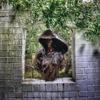The Art of Anna Hyatt Huntington
- December 04, 2020 13:13
At a time when many women were prevented from seeking careers as artists, Anna Hyatt Huntington became one of America’s most famous sculptors. The daughter of a professor of paleontology and zoology, Anna was born in 1876, in Cambridge, Massachusetts. Anna’s father encouraged her to explore the natural world, while pursuing her artistic ambitions. Horses and big cats became objects of admiration, and feature in Anna’s most celebrated works.
In her early twenties, Anna studied animal anatomy. She created dozens of models of jaguars, leopards, lions, and tigers. In 1902, after settling in New York, Anna headed to the Bronx Zoo. There she modeled bison and monkeys, along with her beloved big cats. While she observed the animals first-hand, Anna worked small lumps of clay into rough sketches, which she then developed into larger sculptures in her studio.
At the time, Anna lived in a small apartment, sharing studio space with fellow artists. After she began to exhibit her work, and receive more and more sculpture commissions, Anna became one of the first women ever admitted to the National Academy of Design, the National Sculpture Society, and the American Academy of Arts and Letters. As her career took off, Anna continued to be inspired by the natural beauty of animals, as well as figures of myth and history.
In 1904, Anna’s future husband, Archer “Archie” Milton Huntington, founded the Hispanic Society of America. In 1915, Anna unveiled her monument to Joan of Arc, the first monument in New York City to honor a historical woman. She and Archie were married in 1923, and Anna would go on to produce a number of works to celebrate men and women of Hispanic heritage.
In 1929, Anna and Archie visited Murrells Inlet, South Carolina. Captivated by the beauty of the place, they bought a house there, and began to develop the land around it into a vast sculpture garden. They called it Brookgreen Gardens. Anna’s sculpture collection expanded rapidly, and in 1932, Brookgreen Gardens became a public sculpture garden, the largest and most comprehensive publicly accessible collection of American figurative sculpture in the country.
If you go to Brookgreen Gardens today, you can still see many of Anna’s sculptures on display: In her work, bodies ripple with instinct and emotion. Bronze horses paw the sky. Golden figures come to life. Mythological beings are made real.
To see one of her best-known works of art, visit New York City’s Central Park. At the end of her life, Anna was commissioned to create a bold equestrian statue in honor of José Martí, the Cuban revolutionary. Anna depicts Martí dramatically, at the moment of his martyrdom in the Battle of Dos Ríos. One of the most beloved representations of Cuba’s great poet and national liberator, Anna’s sculpture of Martí is also one of the most famous works of art on display in Central Park.





















